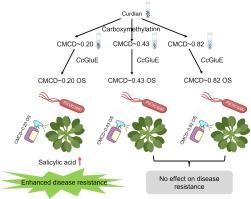羧甲基可得然低聚糖的制备及其在植物病害防治中的应用
IF 5.8
2区 化学
Q1 POLYMER SCIENCE
引用次数: 0
摘要
可得然由微生物发酵产生,是一种不溶于水的β-(1→3)-D-葡聚糖。为了更有效地利用原生可得然,本研究首先制备了不同取代度(DS)的可得然衍生物--羧甲基化可得然(CMCD),取代度分别为 DS ∼ 0.20、DS ∼ 0.43 和 DS ∼ 0.82。与原生可得然相比,羧甲基化可得然在水中的溶解度更高。此外,研究还发现,CMCD 可被 CcGluE(一种内-β-1 → 3-葡聚糖酶)水解,其降解产物为低聚糖,聚合度(DP)主要在 2 至 7 之间。当以 CMCD ∼ 0.43 为底物时,CcGluE 还表现出较高的热稳定性和 pH 稳定性。然后,将这些由不同 CMCD 生成的寡糖应用于拟南芥,并检测了其在经病原菌 Pseudomonas syringae pv tomato DC3000(Pst DC3000)处理后诱导防御反应的活性。CMCD(DS ∼ 0.20)降解寡糖(CMCD ∼ 0.20 OS)预处理是唯一能显著增强对 Pst DC3000 抗病性的预处理。研究结果为可得然的应用提供了新的见解,证明了羧甲基化可以提高可得然在水中的溶解度。此外,CMCD 降解产生的寡糖产品在农业中控制植物病害方面前景广阔。本文章由计算机程序翻译,如有差异,请以英文原文为准。

Preparation of carboxymethylated curdlan oligosaccharides and application on plant disease control
Curdlan is produced by fermentation of microorganisms, which is an insoluble β-(1 → 3)-D-glucans. To better effectively utilize native curdlan, firstly, a derivative from curdlan, carboxymethylated curdlan (CMCD), with different degrees of substitution (DS) DS ∼ 0.20, DS ∼ 0.43 and DS ∼ 0.82 were prepared in this study. Carboxymethylation increases solubility in water more than native curdlan. Moreover, CMCDs were investigated to be hydrolyzed by CcGluE, an endo-β-1 → 3-glucanase and generated the degradation products were oligosaccharides with degrees of polymerization (DP) mainly ranging from 2 to 7. CcGluE also showed high thermal and pH stability when CMCD ∼ 0.43 was used as a substrate. Then these oligosaccharides generated by different CMCDs were applied to Arabidopsis and the activity in inducing defense responses were detected after being treated by the pathogen of Pseudomonas syringae pv tomato DC3000 (Pst DC3000). CMCD (DS ∼ 0.20) degradation oligosaccharide (CMCD ∼ 0.20 OS) pre-treatment was the just one that significantly enhanced the disease resistance to Pst DC3000, which is mediated by the salicylic acid (SA) signaling pathway in plants. The findings offer new insights into the application of curdlan, demonstrating that carboxymethylation enhances its solubility in water. Additionally, the oligosaccharide products derived from CMCD degradation show promising prospects for controlling plant diseases in agriculture.
求助全文
通过发布文献求助,成功后即可免费获取论文全文。
去求助
来源期刊

European Polymer Journal
化学-高分子科学
CiteScore
9.90
自引率
10.00%
发文量
691
审稿时长
23 days
期刊介绍:
European Polymer Journal is dedicated to publishing work on fundamental and applied polymer chemistry and macromolecular materials. The journal covers all aspects of polymer synthesis, including polymerization mechanisms and chemical functional transformations, with a focus on novel polymers and the relationships between molecular structure and polymer properties. In addition, we welcome submissions on bio-based or renewable polymers, stimuli-responsive systems and polymer bio-hybrids. European Polymer Journal also publishes research on the biomedical application of polymers, including drug delivery and regenerative medicine. The main scope is covered but not limited to the following core research areas:
Polymer synthesis and functionalization
• Novel synthetic routes for polymerization, functional modification, controlled/living polymerization and precision polymers.
Stimuli-responsive polymers
• Including shape memory and self-healing polymers.
Supramolecular polymers and self-assembly
• Molecular recognition and higher order polymer structures.
Renewable and sustainable polymers
• Bio-based, biodegradable and anti-microbial polymers and polymeric bio-nanocomposites.
Polymers at interfaces and surfaces
• Chemistry and engineering of surfaces with biological relevance, including patterning, antifouling polymers and polymers for membrane applications.
Biomedical applications and nanomedicine
• Polymers for regenerative medicine, drug delivery molecular release and gene therapy
The scope of European Polymer Journal no longer includes Polymer Physics.
 求助内容:
求助内容: 应助结果提醒方式:
应助结果提醒方式:


